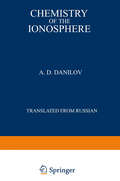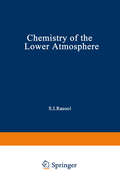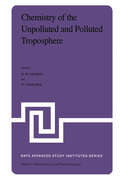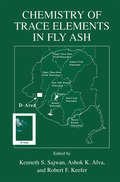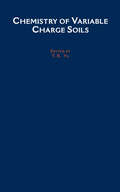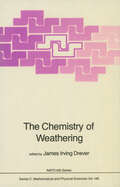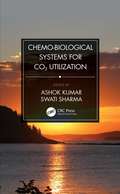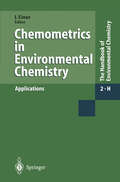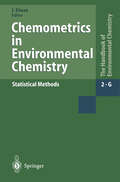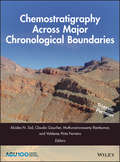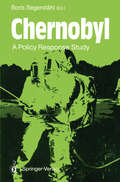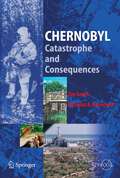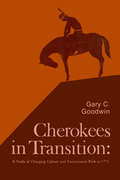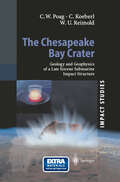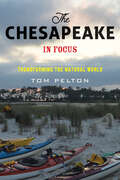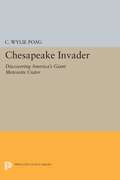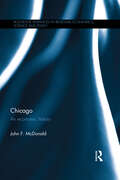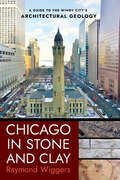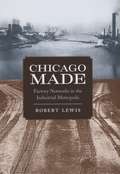- Table View
- List View
Chemistry of the Ionosphere (Monographs in Geoscience)
by A. DanilovI was very happy to learn that Plenum Press has decided to publish an English edition of Chemistry of the Ionosphere. Although the book was largely intended for the Soviet reader in order to fill some gaps in Russian-language reviews on aeronomic problems, I hope that it may be useful to foreign specialists engaged in iono spheric research as well. Naturally, during the time which has elapsed since the preparation of the Russian edition new studies have been published in the world literature on the problems dealt with in this book. The most important of these are noted in the ap pendix to this edition, but some problems (for example, with respect to the physics of negative ions in the lower ionosphere) require a radical reexamination, which cannot be done in a brief appendix. I will be pleased if publication of the book in English will as sist in removing some of the currently existing ambiguities in basic problems of upper atmosphere chemistry. A. D. Danilov Preface to the Russian Edition 1 In the last decade surprising successes have been achieved in the study of the earth's upper atmosphere by use of rockets and artificial satellites. These investigations have made it clear that the upper atmosphere (and particularly the ionospheric region at altitudes 100-1000 km) is a considerably more complex formation than could be visualized prior to the advent of active studies with space vehicles.
Chemistry of the Lower Atmosphere
by S. RasoolAbout three years ago Catherine de Berg and I published a short article in Nature in which we attempted to explain why the chemistry of the atmosphere of the Earth is today so completely different from that of our two neighbor ing planets, Mars and Venus. Our atmosphere is composed mainly of N2 and O with traces of A, H0, CO , 0 , etc. , while the atmospheres of both 2 2 2 3 Mars and Venus are almost entirely made up of CO , Also, the Earth appears 2 to be the only one ofthe three planets which has oceans ofliquid water on the surface. Since the presence of liquid water on Earth is probably an essential requirement for life to have originated and evolved to its present state, the question of the apparent absence ofliquid water on Mars and Venus suddenly acquires significant proportions. In our paper in Nature, and later in a more detailed discussion of the subject (Planetary Atmospheres, in Exobiology, edited by C. Ponnamperuma, North Holland Publishing Co. ), we tried to describe why we believe that in the early history of the solar system all the terrestrial planets lost the atmospheres of H2 and He which they had acquired from the solar nebula at the time of their formation. These planets, completely devoid of atmos pheres, like the Moon today, started accumulating new gases which were exhumed from the interior by the commencement of volcanic activity.
Chemistry of the Unpolluted and Polluted Troposphere: Proceedings of the NATO Advanced Study Institute held on the Island of Corfu, Greece, September 28 – October 10, 1981 (Nato Science Series C: #96)
by H. W. Georgii W. JaeschkeThe content of this book are lectures and research papers presented at the NATO Advanced Study Institute on -Chemistry of the Unpolluted and Polluted Troposphere-held from September 28 to October 10, 1981, on the Island of Corfu, Greece. The realization of the scientific event was made possible by the sponsorship of the NATO Scientific and Environmental Affairs Division. We must express our gratitude first to this Institution for the important assistance and cooperation we received. For additional assistance we are much obliged to our distinguished co sponsors: Carl Zeiss Werk, Oberkochen, FRGj Biotronik GmbH, Frankfurt, FRGj Bodenseewerk Perkin Elmer u. Co GmbH, Ueberlingen, FRGj and TSI Deutschland Inc., Aachen, FRG. To Mr. Dimitris Bouas, the Director of the Grand Hotel Glyfada, we would like to express our thanks and appreciation for the excellent services. The Center of Environmental Protection of the University of Frankfurt, FRG, conducted the NATO Advanced Study Institute because of the rapidly increased interest in the problems of air chemistry and air pollution. This development has contributed in recent years to a significant expansion of knowledge in the field of atmospheric chemistry, where several of the classic disciplines like meteorology, physics and chemistry have joined in combined research. The Advanced Study Institute offered an ideal opportunity to give a comprehensive survey of the present knowledge in this relatively new field of atmospheric science.
Chemistry of Trace Elements in Fly Ash
by Kenneth S. Sajwan Ashok K. Alva Robert F. KeeferThe accumulation of large amounts of ash from fossil fuel combustion for electric power plant generation is becoming a major environmental concern in the United States. Furthermore, stringent environmental regulations mandated by the Environmental Protection Agency through the Clean Air Act, Clean Water Act, Resource Conservation and Recovery Act, as well as state and local environmental regulations may result in even more ash production with subsequent contact with the environment. The concentrations of trace elements in coal residues are extremely variable and depend on the composition of the original coal, conditions during combustion, the efficiency of emission control devices, storage and handling ofbyproducts, and climate. The research papers in this book were presented as a part of the Sixth International Conference on the Biogeochemistry of Trace Elements held at the University of Guelph, Ontario, Canada, from July 29-August 2, 2001. The purpose of this corit'erence was to present current knowledge on the source, pathways, behavior and effects of trace elements in soils, waters, plants and animals. In addition, the book also includes invited research papers from scientists who have done significant research in the area of coal and coal combustion byproducts. All the research papers presented herein have been subjected to peer review.
Chemistry of Variable Charge Soils (Topics in Sustainable Agronomy)
by T. R. YuThis book, based on research carried out at the Academia Sinica over the past 30 years, explains the basic difference between the variable charge soils of tropical and subtropical regions, and the constant charge soils of temperate regions. It will focus on the chemical properties of the variable charge soils--properties which have important bearing on soil management practices, including maximizing soil productivity and combating soil pollution.
The Chemistry of Weathering (Nato Science Series C: #149)
by J. I. DreverSeveral important developments in our understanding of the chemistry of weathering have occurred in the last few years: 1. There has been a major breakthrough in our understanding of the mechanisms controlling the kinetics of sil icate dissolution, and there have been major advances in computer modeling of weathering processes. 2. There has been a growing recognition of the importance of organic solutes in the weathering process, and hence of the inter-relationships between mineral weathering and the terrestrial ecosystem. 3. The impact of acid deposition ("acid rain") has been widely recognized. The processes by which acid deposition is neutral ized are closely related to the processes of normal chemical weathering; an understanding of the chemistry of weathering is thus essential for predicting the effects of acid deposition. 4. More high-qual ity data have become available on the chemical dynamics of smal I watersheds and large river systems, which represent the integrated effects of chemical weathering.
Chemo-Biological Systems for CO2 Utilization
by Ashok Kumar Swati SharmaChemo-Biological Systems for CO2 Utilization describes the most recent advanced tools and techniques for carbon dioxide capture and its utilization. It discusses and compares the advantages of different systems and aids researchers and industrialists in understanding energy generation in the form of biofuels, bioelectricity, or biogas using chemicals; nanomaterials; and microbial, enzymatic, and chemo-enzymatic-integrated systems. It describes the importance and utilization of CO2 in living systems, and provides an overview of the various fundamental methods, policies, and techniques involved in CO2 conversion. Emphasis is placed on the production of value-added products using CO2, including biomethanol, industrial carbonates, and liquid or gaseous fuels. Features: Explains the correlations between microbial, biological, and chemical products and their roles in the conversion of CO2 into usable energy and related products. Being suitable for a broad audience, it addresses fundamental treatment methods for reusing environmental waste materials. Aids in decision-making and policy planning for environmental professionals. The information provided throughout this book will help researchers and professionals working in various industries to better understand the conversion of CO2 into energy-based products. Chemo-Biological Systems for CO2 Utilization also serves as a useful guide to seek alternative methods for clean energy and mitigating global climate change.
Chemo-Biological Systems for CO2 Utilization
by Ashok Kumar Swati SharmaChemo-Biological Systems for CO2 Utilization describes the most recent advanced tools and techniques for carbon dioxide capture and its utilization. It discusses and compares the advantages of different systems and aids researchers and industrialists in understanding energy generation in the form of biofuels, bioelectricity, or biogas using chemicals; nanomaterials; and microbial, enzymatic, and chemo-enzymatic-integrated systems. It describes the importance and utilization of CO2 in living systems, and provides an overview of the various fundamental methods, policies, and techniques involved in CO2 conversion. Emphasis is placed on the production of value-added products using CO2, including biomethanol, industrial carbonates, and liquid or gaseous fuels. Features: Explains the correlations between microbial, biological, and chemical products and their roles in the conversion of CO2 into usable energy and related products. Being suitable for a broad audience, it addresses fundamental treatment methods for reusing environmental waste materials. Aids in decision-making and policy planning for environmental professionals. The information provided throughout this book will help researchers and professionals working in various industries to better understand the conversion of CO2 into energy-based products. Chemo-Biological Systems for CO2 Utilization also serves as a useful guide to seek alternative methods for clean energy and mitigating global climate change.
Chemometrics in Environmental Chemistry - Applications (The Handbook of Environmental Chemistry #2 / 2H)
by A. A. Christy L. Eriksson M. Feinberg J.L.M. Hermens H. Hobert P. K. Hopke O. M. Kvalheim R. D. McDowall D. R. Scott J. WebsterPattern recognition and other chemometrical techniques are important tools in interpreting environmental data. This volume presents authoritatively state-of-the-art applications of measuring and handling environmental data. The chapters are written by leading experts.
Chemometrics in Environmental Chemistry - Statistical Methods (The Handbook of Environmental Chemistry #2 / 2G)
by T. E. Barnard K. S. Booksh R. G. Brereton D. H. Coomans S. N. Deming Y. Hayashi Y. L. Mallet R. Matsuda J. M. Nocerino R. A. Olivero Ajay Singh H. C. Smit O. Y. DeVel Z. WangPattern recognition and other chemometrical techniques are important tools in interpreting environmental data. This volume presents authoritatively state-of-the-art procedures for measuring and handling environmental data. The chapters are written by leading experts.
Chemostratigraphy Across Major Chronological Boundaries (Geophysical Monograph Series #240)
by Alcides N. Sial Claudio Gaucher Muthuvairavasamy Ramkumar Valderez Pinto FerreiraExploring environmental changes through Earth’s geological history using chemostratigraphy Chemostratigraphy is the study of the chemical characteristics of different rock layers. Decoding this geochemical record across chronostratigraphic boundaries can provide insights into geological history, past climates, and sedimentary processes. Chemostratigraphy Across Major Chronological Boundaries presents state-of-the-art applications of chemostratigraphic methods and demonstrates how chemical signatures can decipher past environmental conditions. Volume highlights include: Presents a global perspective on chronostratigraphic boundaries Describes how different proxies can reveal distinct elemental and isotopic events in the geologic past Examines the Archaean-Paleoproterozoic, Proterozoic-Paleozoic, Paleozoic-Mesozoic, and Mesozoic-Paleogene boundaries Explores cause-and-effect through major, trace, PGE, and REE elemental, stable, and radiogenic isotopes Offers solutions to persistent chemostratigraphic problems on a micro-global scale Geared toward academic and researchgeoscientists, particularly in the fields of sedimentary petrology, stratigraphy, isotope geology, geochemistry, petroleum geology, atmospheric science, oceanography, climate change and environmental science, Chemostratigraphy Across Major Chronological Boundaries offers invaluable insights into environmental evolution and climatic change.Read the Editors' Vox: https://eos.org/editors-vox/unravelling-the-past-using-elements-and-isotopes
Chemostratigraphy Across Major Chronological Boundaries (Geophysical Monograph Series #240)
by Alcides N. Sial Claudio Gaucher Muthuvairavasamy Ramkumar Valderez Pinto FerreiraExploring environmental changes through Earth’s geological history using chemostratigraphy Chemostratigraphy is the study of the chemical characteristics of different rock layers. Decoding this geochemical record across chronostratigraphic boundaries can provide insights into geological history, past climates, and sedimentary processes. Chemostratigraphy Across Major Chronological Boundaries presents state-of-the-art applications of chemostratigraphic methods and demonstrates how chemical signatures can decipher past environmental conditions. Volume highlights include: Presents a global perspective on chronostratigraphic boundaries Describes how different proxies can reveal distinct elemental and isotopic events in the geologic past Examines the Archaean-Paleoproterozoic, Proterozoic-Paleozoic, Paleozoic-Mesozoic, and Mesozoic-Paleogene boundaries Explores cause-and-effect through major, trace, PGE, and REE elemental, stable, and radiogenic isotopes Offers solutions to persistent chemostratigraphic problems on a micro-global scale Geared toward academic and researchgeoscientists, particularly in the fields of sedimentary petrology, stratigraphy, isotope geology, geochemistry, petroleum geology, atmospheric science, oceanography, climate change and environmental science, Chemostratigraphy Across Major Chronological Boundaries offers invaluable insights into environmental evolution and climatic change.Read the Editors' Vox: https://eos.org/editors-vox/unravelling-the-past-using-elements-and-isotopes
Chern-Simons Theory and Equivariant Factorization Algebras (BestMasters)
by Corina KellerCorina Keller studies non-perturbative facets of abelian Chern-Simons theories. This is a refinement of the entirely perturbative approach to classical Chern-Simons theory via homotopy factorization algebras of observables that arise from the associated formal moduli problem describing deformations of flat principal bundles with connections over the spacetime manifold. The author shows that for theories with abelian group structure, this factorization algebra of classical observables comes naturally equipped with an action of the gauge group, which allows to encode non-perturbative effects in the classical observables.About the Author: Corina Keller currently is a doctoral student in the research group of Prof. Dr. Damien Calaque at the Université Montpellier, France. She is mostly interested in the mathematical study of field theories. Her master’s thesis was supervised by PD Dr. Alessandro Valentino and Prof. Dr. Alberto Cattaneo at Zurich University, Switzerland.
Chernobyl: A Policy Response Study (Springer Series on Environmental Management)
by Boris SegerståhlThis series is dedicated to serving the growing community of scholars and practitioners concerned with the principles and applications of environmental management. Each volume is a thorough treatment of a specific topic of importance for proper management practices. A fundamental objective of these books is to help the reader discern and implement man's stewardship of our environment and the world's renewable resources. For we must strive to understand the relation ship between man and nature, act to bring harmony to it, and nurture an environment that is both stable and productive. These objectives have often eluded us because the pursuit of other individual and societal goals has diverted us from a course of living in balance with the environment. At times, therefore, the environmental manager may have to exert restrictive control, which is usually best applied to man, not nature. Attempts to alter or harness nature have often failed or backfired, as exemplified by the results of imprudent use of herbicides, fertilizers, water, and other agents. Each book in this series will shed light on the fundamental and applied aspects of environmental management. It is hoped that each will help solve a practical and serious environmental problem.
Chernobyl: Catastrophe and Consequences (Springer Praxis Books)
by Jim Smith Nicholas A. BeresfordAs the debate about the environmental cost of nuclear power and the issue of nuclear safety continues, a comprehensive assessment of the Chernobyl accident, its long-term environmental consequences and solutions to the problems found, is timely. Although many books have been published which discuss the accident itself and the immediate emergency response in great detail, none have dealt primarily with the environmental issues involved. The authors provide a detailed review of the long-term environmental consequences, in a wide range of ecosystems, many of which are only now becoming apparent. They also highlight responses and counter-measures to combat the environmental consequences and discuss health, social, psychological and economic impacts on the human population as well as the long-term effects on biota.
Cherokees in Transition: A Study of Changing Culture and Environment Prior to 1775 (University of Chicago Geography Research Papers #no. 181.)
by Gary C. GoodwinCherokees in Transition offers a comprehensive description from an eco-historical perspective of the multitudinous changes that occurred within the Cherokee cultural-environmental system during the period preceding the American Revolution.
The Chesapeake Bay Crater: Geology and Geophysics of a Late Eocene Submarine Impact Structure (Impact Studies)
by Wylie Poag Christian Koeberl Wolf Uwe ReimoldThe authors have synthesized 16 years of geological and geophysical studies which document an 85-km-wide impact crater buried 500 m beneath Chesapeake Bay in south eastern Virginia, USA. In doing so, they have integrated extensive seismic reflection profiling and deep core drilling to analyze the structure, morphology, gravimetrics, sedimentology, petrology, geochemistry, and paleontology of this submarine structure. Of special interest are a detailed comparison with other terrestrial and extraterrestrial craters, as well as a conceptual model and computer simulation of the impact. The extensive illustrations encompass more than 150 line drawings and core photographs.
The Chesapeake in Focus: Transforming the Natural World
by Tom PeltonWhen Captain John Smith arrived in Virginia in 1607, he discovered a paradise in the Chesapeake Bay. In the centuries that followed, the Bay changed vastly;¢;‚¬;€?and not for the better. European landowners and enslaved Africans slashed, burned, and cleared the surrounding forests to grow tobacco. Watermen overfished oysters, shad, and sturgeon, decimating these crucial species. Baltimore, Washington, and Richmond used its rivers as urban sewers. By the 1960s, the Chesapeake was dying.A crossroads of life and culture, the Chesapeake straddles the North and the South, mixes salt water with fresh, and is home to about 18 million people and 3,600 species of animals and plants. Although recent cleanup efforts have improved its overall health, they have not been enough to save this national treasure. In The Chesapeake in Focus, award-winning writer Tom Pelton examines which environmental policies have worked and which have failed. Based on Pelton;€™s extensive experience as a journalist and as the host of the public radio program The Environment in Focus, this sweeping book takes readers on a tour of the histories of the Chesapeake, as well as the ecological challenges faced by its major tributaries. It details the management of blue crabs, striped bass, and other delicious wildlife, profiles leaders and little-known characters involved in the restoration campaign, and warns of the dangers of anti-regulatory politics that threaten to reverse what has been accomplished. Looking to the future, Pelton offers a provocative vision of the hard steps that must be taken if we truly want to save the Bay.
The Chesapeake in Focus: Transforming the Natural World
by Tom PeltonWhen Captain John Smith arrived in Virginia in 1607, he discovered a paradise in the Chesapeake Bay. In the centuries that followed, the Bay changed vastly;¢;‚¬;€?and not for the better. European landowners and enslaved Africans slashed, burned, and cleared the surrounding forests to grow tobacco. Watermen overfished oysters, shad, and sturgeon, decimating these crucial species. Baltimore, Washington, and Richmond used its rivers as urban sewers. By the 1960s, the Chesapeake was dying.A crossroads of life and culture, the Chesapeake straddles the North and the South, mixes salt water with fresh, and is home to about 18 million people and 3,600 species of animals and plants. Although recent cleanup efforts have improved its overall health, they have not been enough to save this national treasure. In The Chesapeake in Focus, award-winning writer Tom Pelton examines which environmental policies have worked and which have failed. Based on Pelton;€™s extensive experience as a journalist and as the host of the public radio program The Environment in Focus, this sweeping book takes readers on a tour of the histories of the Chesapeake, as well as the ecological challenges faced by its major tributaries. It details the management of blue crabs, striped bass, and other delicious wildlife, profiles leaders and little-known characters involved in the restoration campaign, and warns of the dangers of anti-regulatory politics that threaten to reverse what has been accomplished. Looking to the future, Pelton offers a provocative vision of the hard steps that must be taken if we truly want to save the Bay.
Chesapeake Invader: Discovering America's Giant Meteorite Crater (PDF)
by C. Wylie PoagThirty-five million years ago, a meteorite three miles wide and moving sixty times faster than a bullet slammed into the sea bed near what is now Chesapeake Bay. The impact, more powerful than the combined explosion of every nuclear bomb on Earth, blasted out a crater fifty miles wide and one mile deep. Shock waves radiated through the Earth for thousands of miles, shaking the foundations of the Appalachians, as gigantic waves and winds of white-hot debris transformed the eastern seaboard into a lifeless wasteland. Chesapeake Invader is the story of this cataclysm, told by the man who discovered it happened. Wylie Poag, a senior scientist with the U.S. Geological Survey, explains when and why the catastrophe occurred, what destruction it caused, how scientists unearthed evidence of the impact, and how the meteorite's effects are felt even today. Poag begins by reviewing how scientists in the decades after World War II uncovered a series of seemingly inexplicable geological features along the Virginia coast. As he worked to interpret one of these puzzling findings in the 1980s in his own field of paleontology, Poag began to suspect that the underlying explanation was the impact of a giant meteorite. He guides us along the path that he and dozens of colleagues subsequently followed as--in true scientific tradition--they combined seemingly outrageous hypotheses, painstaking research, and equal parts good and bad luck as they worked toward the discovery of what turned out to be the largest impact crater in the U.S. We join Poag in the lab, on deep-sea drilling ships, on the road for clues in Virginia, and in heated debates about his findings. He introduces us in clear, accessible language to the science behind meteorite impacts, to life and death on Earth thirty-five million years ago, and to the ways in which the meteorite shaped the Chesapeake Bay area by, for example, determining the Bay's very location and creating the notoriously briny groundwater underneath Virginia. This is a compelling work of geological detective work and a paean to the joys and satisfactions of a life in science.Originally published in 1999.The Princeton Legacy Library uses the latest print-on-demand technology to again make available previously out-of-print books from the distinguished backlist of Princeton University Press. These editions preserve the original texts of these important books while presenting them in durable paperback and hardcover editions. The goal of the Princeton Legacy Library is to vastly increase access to the rich scholarly heritage found in the thousands of books published by Princeton University Press since its founding in 1905.
Chicago: An economic history (Routledge Advances in Regional Economics, Science and Policy)
by John F. McDonaldChicago went from nothing in 1830 to become the second-largest city in the nation in 1900, while the Midwest developed to become one of the world’s foremost urban areas. This book is an economic history of the Chicago metropolitan area from the 1820s to the present. It examines the city in its Midwestern region and compares it to the other major cities of the North. This book uses theories of the economics of location and other economic models to explain much of Chicago’s history. Chicago maintained its status as the second-largest city through the first decades of the 20th century, but rapid growth shifted to the Sunbelt following World War II. Since the 1950s the city’s history can be divided into four distinct periods; growth with suburbanization (1950-1970), absence of growth, continued suburbanization, and central city crisis (1970-1990), rebound in the 1990s, and financial crisis and deep recession after 2000. Through it all Chicago has maintained its position as the economic capital of the Midwest. The book is a synthesis of available literature and public data, and stands as an example of using economics to understand much of the history of Chicago. This book is intended for the college classroom, urban scholars, and for those interested in the history of one of world’s foremost urban areas.
Chicago: An economic history (Routledge Advances in Regional Economics, Science and Policy)
by John F. McDonaldChicago went from nothing in 1830 to become the second-largest city in the nation in 1900, while the Midwest developed to become one of the world’s foremost urban areas. This book is an economic history of the Chicago metropolitan area from the 1820s to the present. It examines the city in its Midwestern region and compares it to the other major cities of the North. This book uses theories of the economics of location and other economic models to explain much of Chicago’s history. Chicago maintained its status as the second-largest city through the first decades of the 20th century, but rapid growth shifted to the Sunbelt following World War II. Since the 1950s the city’s history can be divided into four distinct periods; growth with suburbanization (1950-1970), absence of growth, continued suburbanization, and central city crisis (1970-1990), rebound in the 1990s, and financial crisis and deep recession after 2000. Through it all Chicago has maintained its position as the economic capital of the Midwest. The book is a synthesis of available literature and public data, and stands as an example of using economics to understand much of the history of Chicago. This book is intended for the college classroom, urban scholars, and for those interested in the history of one of world’s foremost urban areas.
Chicago in Stone and Clay: A Guide to the Windy City's Architectural Geology
by Raymond WiggersChicago in Stone and Clay explores the interplay between the city's most architecturally significant sites, the materials they're made of, and the sediments and bedrock they are anchored in. This unique geologist's survey of Windy City neighborhoods demonstrates the fascinating and often surprising links between science, art, engineering, and urban history. Drawing on two decades of experience leading popular geology tours in Chicago, Raymond Wiggers crafted this book for readers ranging from the region's large community of amateur naturalists, "citizen scientists," and architecture buffs to geologists, architects, educators, and other professionals seeking a new perspective on the themes of architecture and urbanism. Unlike most geology and architecture books, Chicago in Stone and Clay is written in the informal, accessible style of a natural history tour guide, humanizing the science for the nonspecialist reader. Providing an exciting new angle on both architecture and natural history, Wiggers uses an integrative approach that incorporates multiple themes and perspectives to demonstrate how the urban environment presents us with a rich geologic and architectural legacy.
Chicago Made: Factory Networks in the Industrial Metropolis (Historical Studies of Urban America)
by Robert LewisFrom the lumberyards and meatpacking factories of the Southwest Side to the industrial suburbs that arose near Lake Calumet at the turn of the twentieth century, manufacturing districts shaped Chicago’s character and laid the groundwork for its transformation into a sprawling metropolis. Approaching Chicago’s story as a reflection of America’s industrial history between the Civil War and World War II, Chicago Made explores not only the well-documented workings of centrally located city factories but also the overlooked suburbanization of manufacturing and its profound effect on the metropolitan landscape. Robert Lewis documents how manufacturers, attracted to greenfield sites on the city’s outskirts, began to build factory districts there with the help of an intricate network of railroad owners, real estate developers, financiers, and wholesalers. These immense networks of social ties, organizational memberships, and financial relationships were ultimately more consequential, Lewis demonstrates, than any individual achievement. Beyond simply giving Chicago businesses competitive advantages, they transformed the economic geography of the region. Tracing these transformations across seventy-five years, Chicago Made establishes a broad new foundation for our understanding of urban industrial America.
